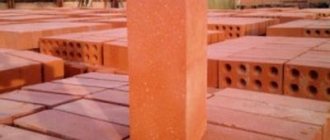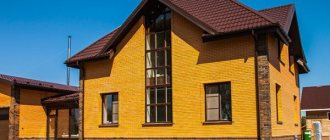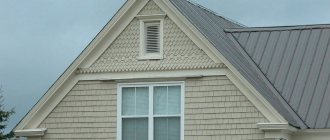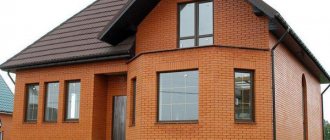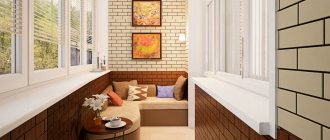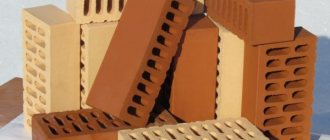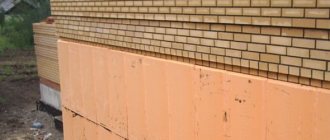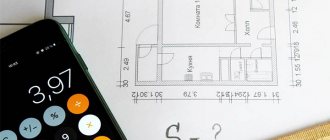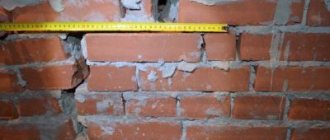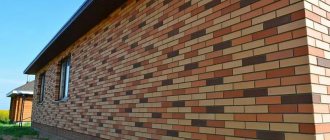To reliably and permanently protect the walls of the facade, as well as to give them a decorative design, facing bricks are used.
The coating for facades differs from ordinary brick in appearance and structure: it is lighter and has clear, even edges.
Facade material may differ in composition, color, shape, and size.
To correctly calculate the required amount of façade material, you must be guided by the size of the elements and the coverage area.
It is imperative that, taking into account each masonry pattern, you should select a certain number of bricks of different sizes.
Dimensions of facing bricks in 1m2 of masonry
In terms of size, the components can be standard (according to GOST) and European. The size does not affect the quality of the product in any way; the Russian size standard is selected in such a way that it is convenient to join spoons (long sides) as well as pokes (short sides).
For Europeans, the use of non-standard sizes emphasizes the uniqueness of the structure, so in production they do not take into account the adjustment of the dimensions of the component parts to the masonry pattern.
Bricks can be:
- single (standard (mm) - 250x120x65);
- one and a half (standard (mm) - 250x120x88);
- double (standard (mm) - 250x120x138).
According to European standards, facade bricks are produced in the following sizes (mm)::
- WF210x100x50;
- WDF210x100x65;
- DF240x115x52;
- 2DF240x115x113.
The first number indicates the longest edge of the element, the second - the short side of the pastel (working surface of the element), the third - the height of the part.
Brick parameters
The facing brick supplied by Vertical Group has standard dimensions. The dimensions of a single facing brick are:
- length – 250 mm;
- width – 120 mm;
- height – 65 mm.
One-and-a-half bricks are taller than single bricks. Its dimensions:
- length – 250 mm;
- width – 120 mm;
- height – 88 mm.
The long narrow side of the brick is usually called a spoon, and the short end side is a poke. The area of the spoon side, calculated as the product of the length and height of the brick, is:
- single – 250mm*65mm=16250mm2 or 0.01625 square meters;
- one and a half – 250mm*88mm=22000mm2 or 0.02200 square meters.
The butt side has an area that is calculated as the product of the width and height of the brick:
- single – 120mm*65mm=7800mm2 or 0.0078 square meters;
- one and a half – 120mm*88mm=10560mm2 or 0.01056 square meters.
Types of masonry
Before calculating the required amount of material, you should decide on the masonry pattern. The masonry can be made using different colors to emphasize the expressiveness of the design and add originality.
Types of brickwork differ in their external pattern.
Among the variety of options, the most popular ones can be identified:
- block . Rows with the long part of the part are alternately laid on every second row with the short side. The joints match;
- gothic _ The parts are assembled in the same way, similar to the block version, only the joints are shifted;
- path . Laying is carried out with the long part from the front part in all rows, in each row the joints are shifted by half the length of the element;
- Lipetskaya _ Three rows of long sides, the next one - short. The joints do not move;
- tychkovaya _ Elements are laid only with the butt side offset;
- spoon _ The elements are laid only with the spoon part with an offset of half a brick or ¼;
- Brandenburg . The masonry is done alternately: two elements with a spoon part, one with a bonded part. In each row, a shift is made so that the butt element is at the junction of both spoon parts.
In addition, there are other types of masonry: cross, Dutch, modified Brandenburg, Flemish, Silesian. In addition, they often use a chaotic method, when a certain pattern is not followed, but elements of different colors are placed randomly.
Most often, when working without a planned design, they resort to using several colors of parts. In order to calculate how much façade material should be used, you should correctly calculate the area of the façade walls .
Seam thickness
There is a standard maximum masonry joint width:
- vertical seam – thickness does not exceed 10 mm;
- horizontal – 12.
The size may be smaller; the maximum is taken for calculation. The relationship between the thickness of the seam and the number of stones is inversely proportional. The thicker the seam, the fewer blocks are used.
It is difficult to carry out this type of calculation on your own, because you need to count the number of seams (vertical, horizontal separately), sum up their length, and calculate the occupied area.
Violation of the dimensions of the masonry seam
For example, let’s take a half-brick masonry of standard stone, which according to our calculations includes 62 blocks. If one meter square of the wall plane is shaped like a square, then it is clear that its sides are equal to 1 m. Now a few calculations:
- The height is 0.065 m, which means 1:0.065 = 15 pieces laid at the height of the masonry. That is, 15 rows will be laid in height.
- Length – 0.125, which means 1:0.125 = 8 pieces, stacked lengthwise.
We can conclude that there will be 7 vertical seams and 14 horizontal seams. Here there is a decrease by one, because the last seam will not fit into a square meter, both horizontally and vertically. Both have a length of 1 m, which means that the length of the vertical seams is 7 m, horizontal 14 m.
Now we find their area:
- horizontal: 14x0.012=0.168 m²;
- vertical: 7x0.01=0.07.
The total value is 0.168+0.07=0.238 m².
This indicator must be subtracted from 1 m²: 1-0.238 = 0.762 m². It is this value that is taken when calculating the consumption of bricks. For example, for a standard half-brick masonry, the quantity will be as follows:
0.762: 0.016=48 blocks. This is the final result, provided the block fits at half its length. That is, when laying half a brick.
In principle, the number of bricks for different locations and types of masonry are standardized. There is no need to make complex calculations. The table shows the required ratios.
| type of masonry | Brick type | ||
| single | one and a half | double | |
| Half a brick | 31 | 39 | 26 |
| Into the brick | 102 | 68 | 52 |
| At one and a half | 153 | 117 | 78 |
| In two blocks | 204 | 156 | 104 |
| At two and a half | 255 | 195 | 130 |
Let us add that red brick is often used for cladding buildings with a joint thickness less than that indicated above. Therefore, its quantity is standard - 54 pieces. If standard facing material is used for finishing, then its quantity is 85, large facing block - 14 stones.
Attention! To the calculated value when purchasing building materials, you must add 5-7% for defects and damage.
The latter is in terms of calculating such an indicator as brick consumption, which concerns the silicate type. The same mathematical calculations apply here. The only difference is the standard block height of 65 mm.
Dimensions of white sand-lime brick
How to correctly calculate the wall area
The determination of the working surface is calculated sequentially using some calculations:
- measure the length, height of the surface, then multiply these indicators. A similar calculation must be performed for each standard (rectangular or square) wall;
- add up the area of all the walls of the facade;
- measure the length and height of the windows, calculate the product of these indicators for each window;
- similarly to windows, calculate the area of doors;
- from the sum of the areas of all facade walls, subtract the sum of the areas of all windows and doors of the facade.
The resulting result will be exactly the area that needs to be covered with brick. When the necessary calculations have been made, you can begin to calculate the required amount of facade material.
IMPORTANT!
When calculating the area covered by facing masonry, you should add material for the design of corners and openings, and also take into account the size of the jointing.
Moreover, it is imperative to take into account damage or errors during the installation process, which obliges you to purchase building components with a slight surplus.
Seam size and masonry mesh
The standard calculation of bricks for masonry, which is performed by any online calculator, is carried out using a standard value of 10 mm for both horizontal and vertical joints. This is always the case, with the possible exception of cases with double ceramites, when the recommended seam size is 15 mm.
Another detail that is sometimes included in the calculation is masonry mesh. This is far from mandatory, but sometimes very advisable, because it strengthens the structure of the wall. Masonry mesh is produced in the form factors of panels and tapes using various materials: steel, heat-strengthened and composite.
Masonry mesh for wall construction Source www.metallosetka.ru
Amount of solution per 1 m²
The strength of masonry directly depends on the cement, the correctness of its preparation, and its composition. When calculating the solution, it is necessary to take into account the water absorption of the building material, seasonality of work, and the porosity of the surface of the elements .
NOTE!
If the brick is porous, then it requires more mixture.
The solution for a porous structure should be mixed approximately 20% more than the calculated value.
According to the norm, the consumption of mortar for facade cladding depends on the thickness of the wall.
So, for laying a brick ¼ thick, the required mortar is required depending on the brand of material:
- for M100 - 5 kg;
- for M75 - 4 kg;
- for M50 - 2.5 kg.
You can also calculate how much solution is required for ceramic and silicate composition, based on the standards for 1 m² of wall:
- cladding thickness 25 cm - 0.62 m² (for ceramic or sand-lime brick);
- wall thickness 38 cm - 0.095 m² (for a hollow look);
- width 25 cm - 0.05 m² (for a hollow look).
So, if the composition of the mixture assumes a consumption of 1/3, then for a hollow material with a masonry width of 38 cm, the calculation should be made as follows: 0.095x490. The result is 47 kg of solution.
If the solution is prepared correctly, then the consumption will be as close as possible to the standards.
How much single brick is needed?
When calculating the amount of brick per 1 m² of masonry, you should be guided by average indicators.
So, for a single material according to the type of masonry, the following size of bricks with and without mortar joints is required:
- half a brick - 61 pcs. (without seams), 51 pcs. (with mortar joints);
- one element - 128, 102 pcs.;
- one and a half - 189, 153 pcs.;
- two elements - 256, 204 pcs.;
- two and a half elements - 317, 255 pcs.
For bricks of other sizes, there are other indicators. The data approximately reflects the amount of material that is required, based on different dimensions of the parts.
For one and a half
For a one-and-a-half element, depending on the method of work, the number of parts without seams and with mortar seams is required:
- half a brick - 45, 39 pcs. (with mortar joints);
- one brick - 95, 78 pcs.;
- one and a half elements - 140, 78 pcs.;
- two - 190, 156 pcs.;
- two and a half - 235, 195 pcs.
For double
For double material according to the masonry structure, the following number of parts without seams and with seams is required:
- half a brick - 30, 26 pcs. (with mortar joints);
- one - 60, 52 pcs.;
- one and a half elements - 90, 52 pcs.;
- two - 120, 104 pcs.;
- two and a half bricks - 150, 130 pcs.
You can calculate the number of parts per 1 m² yourself; it will be approximately the same as according to the standards.
To do this you should:
- calculate the area of one element (the product of the height and the long edge);
- calculate the number of parts in 1 m²;
- The volume should be divided by the area of one part.
This is how the number of bricks in 1 m of masonry without seams is obtained for a one and a half type of facade material. For seams, you can add about 1 cm to each length.
After adding for the one-and-a-half element, the size of the standard element is 26x7. With such indicators, you should calculate the volume of the part and the quantity in 1 m² (square meter).
IMPORTANT!
To determine the number of bricks based on the surface area of the facade, the error for all types of material should be taken into account, which is approximately 1.9%.
In addition, taking into account the breakage (5%), it is possible to determine how much material of a particular size is needed for facing work.
Number of bricks per square meter of masonry
Designing a house is not only drawing up drawings, but also calculating the design and financial investments in construction at competitive prices. When building a house, you will need to find the number of bricks per 1 m2.
The calculation is carried out taking into account the features of the construction of structures:
- Type of suture dressing.
- Wall thickness.
- Dimensions of a masonry unit.
Basic terms
Brick is a building material made from mineral components in the shape of a rectangular parallelepiped. Used to create:
- External walls of the house.
- Internal partitions.
- Pillars and supports.
Dimensions according to GOST 530-2012:
| View | Designation | Length, cm | Width, cm | Thickness, cm |
| Single | KR | 25 | 12 | 6.5 |
| One and a half | 8.8 | |||
| Double | 13 | |||
| Modular single | 28.8 | 13.8 | 65 | |
| Modular thickened | 88 | |||
| With horizontal voids | KRG | 25 | 12 | 88 |
| 20 | 70 | |||
| "Euro" | KE | 25 | 85 | 65 |
| Facing | Similar to masonry (KR) | |||
| Designation | Length, cm | Width, cm | Thickness, cm |
| W.F. | 21 | 10 | 5 |
| WDF | 6.5 | ||
| DF | 24 | 115 | 5.2 |
| 2DF | 11.3 |
Types of masonry - several methods of installing the material, determining the location of individual elements in relation to each other of each layer of the structure:
The number of facing bricks in a pallet depending on the type
To optimize shipment and safety of brick material, manufacturers store it in batches on wooden pallets.
Pallets for facing material are used in two types:
- 52x103 cm (small);
- 77x103 cm (large).
As a rule, the manufacturer indicates how many elements are in one pallet. If such an indicator is missing, then you can calculate how many pieces are in the first row of the pallet using the following formula: divide the area of the pallet by the area of the part. Multiply the result by the number of rows laid on one pallet.
According to the standard, the following number of parts (pieces) is placed on board pallets 77 cm wide::
- standard (25x12x6.5) - 420;
- one and a half (25x12x8.8) - 390;
- double (25x12x13.8) - 200;
- double with corrugation - 192;
- M150 - 280;
- single with torn edge - 308;
- corner with torn edge - 352;
- basement - 478.
It is not difficult to understand how many pallets are needed for a certain area.
Brick sizes
Manufacturers today offer several items related to sizes. Even if we talk about one model. A common type is red brick. It has three size options:
- 250x120x65 mm – standard single brick;
- 250x120x88 – one-and-a-half model;
- 250x120x138 – double.
Types of bricks by size
Please note that two parameters – length and width – are the same, the only difference is the height. It is the size that affects the number of bricks. For example, if we take into account brickwork of half a stone, then the blocks are laid lengthwise along the wall in a single row. From here the amount of stone per 1 m² is calculated. You need to calculate the area of the spoon, this is the long side of the brick. That is, the length is multiplied by the height:
- single brick – 250x65 or 0.25x0.065=0.016 m²;
- one and a half – 0.25x0.088=0.022;
- double – 0.25x0.138=0.035.
Names of brick stone planes
Now the amount of red brick in the wall masonry is calculated. You need to divide 1 m² by the area of the spoon.
- 1:0.016=62.5 pieces;
- 1:0,022=45,5;
- 1:0,035=28,5.
If the masonry is made of at least one brick, then the stones are placed mixed together - with a spoon and a poke. It all depends on how many stones are stacked. Most often, four spoon rows are laid, one bond row. This type of masonry has virtually no effect on the number of bricks, if we are only talking about masonry without seams. Because the size of the poke is half the size of a spoon. Stones placed next to each other with a poke - a whole brick laid with a spoon.
There is another type of masonry mixed - stones are laid in one row with a poke and a spoon. The so-called Flemish masonry, it is shown in the photo below.
Types of brickwork
The calculation is carried out taking into account not the length of the block, but the total length of the butt and spoon, that is, one and a half sizes equal to 370 mm (0.37 m). The calculated area of one and a half stone is equal to:
- single – 0.37x0.065=0.024 m²;
- one and a half – 0.37x0.088=0.033;
- double – 0.37x0.138=0.05.
Calculate how many bricks are needed in this type of masonry:
- 1:0.024=42 pieces;
- 1:0,033=33,3;
- 1:0,05=20.
This is the number of bricks (two) laid: one with a poke, the other with a spoon. That is, the calculated indicators need to be doubled. Accordingly, the quantities are: 84, 67, 40.
Generalization on the topic
The indicated calculations determining the number of brick blocks in different positions are a requirement regarding the amount of building material. Brick is one of the most popular building materials, so its quantity in wall masonry and on pallets has been calculated for a long time. These indicators are standardized, they are freely available, so there are no problems with them.
If you need to independently calculate these values, then use the calculations shown in the article.
Video:
How much solution is needed?
To calculate this parameter, let’s take the unit of measurement as a bag of dry masonry mixture weighing 25 kilograms.
We get the following values: (the norm per 1 m3 of masonry is indicated in brackets)
- for 1 m2 of masonry with a thickness of 0.5, one and a half (12.5) bags are needed;
- for single thickness – 4.1 (16.2);
- for a thickness of one and a half bricks - 6.4 (16.6);
- for a thickness of two bricks - 8.3 (17.2).
Do you know how to insulate the outside walls of a house? This article discusses the best insulation materials.
How many bricks are there in 1 m2
Today you will learn how to correctly calculate the correct amount of brick per square meter of masonry.
There is an article on the blog that describes in detail how to calculate the amount of brick in a cubic meter of masonry.
Online calculation
Currently, there are a huge number of online calculators on the Internet to calculate brick consumption.
All you need is:
- Enter the words into the search - online brick calculation calculator;
- Select and open the page with the calculator;
- Enter the initial data into the table;
- Get accurate calculations.
Thus, you will effortlessly obtain the required data in a short period of time.
Table
There are standards for brick consumption that can be found on the Internet in the form of tables.
The basis is a standard size brick and a standard masonry joint equal to 12 millimeters.
Using this table, you can easily calculate the material consumption for the entire length of a solid wall.
But even here, not everything is so simple; often the averaged data may differ from the actual material consumption. This is influenced by many factors.
Calculation of bricks per 1 square meter for the construction of a residential building
In brick construction, one of the most important stages is calculating the required amount of building materials; for example, it is always necessary to know exactly the consumption of bricks per 1 m2 of masonry. In particular, it is very important to be able to correctly determine the amount of brick required; compliance with the pace of construction and completion of construction on time depends on this. Depending on the type of masonry, builders use different methods for determining the required amount of brick or the average consumption of bricks per 1 sq.m of masonry;
Factors influencing the number of bricks in a masonry
The number of bricks in a masonry is influenced by 2 factors:
- thickness of mortar joints;
- the type of brick used (one-and-a-half, double or single).
At first glance, it may seem that mortar joints are so insignificant in thickness that they can be neglected, but this is not so. In fact, in a cube of masonry, approximately 0.25 - 0.3 of the volume is accounted for by the mortar that holds the bricks together.
Neglecting mortar joints is the most common mistake when calculating the number of bricks in a masonry cube.
Design masonry thickness
When the time comes to plan the purchase of materials for the construction of country houses, their characteristics are usually already known: if it is a ceramite fence or an internal partition of a room, the masonry will be half a brick, a utility shed will be made a whole block thick, and for the outer wall of a residential building no less than one and a half ceramite. Depending on the purpose, the following main types of the main element of masonry are distinguished:
- Red brick is the most durable, used in the construction of load-bearing structures and can be single, one-and-a-half, or double in volume.
- White silicate block is used for non-critical structures: internal partitions and gazebos, to give the facade an attractive appearance. This type is not produced in double volume form.
- Facing ceramite is used to decorate individual structures of architectural objects, and is single in size with deviations in one direction or another.
To determine how many bricks are in 1 m² of masonry, you need to take into account factors that influence the desired result: the first is the thickness of the walls . It was mentioned above, measured by the length of standard ceramite: ½ part, a whole block, one and a half, two or more bricks.
The second factor is the size of the ceramite itself: single, one-and-a-half or double. Each of them has its own dimensions.
